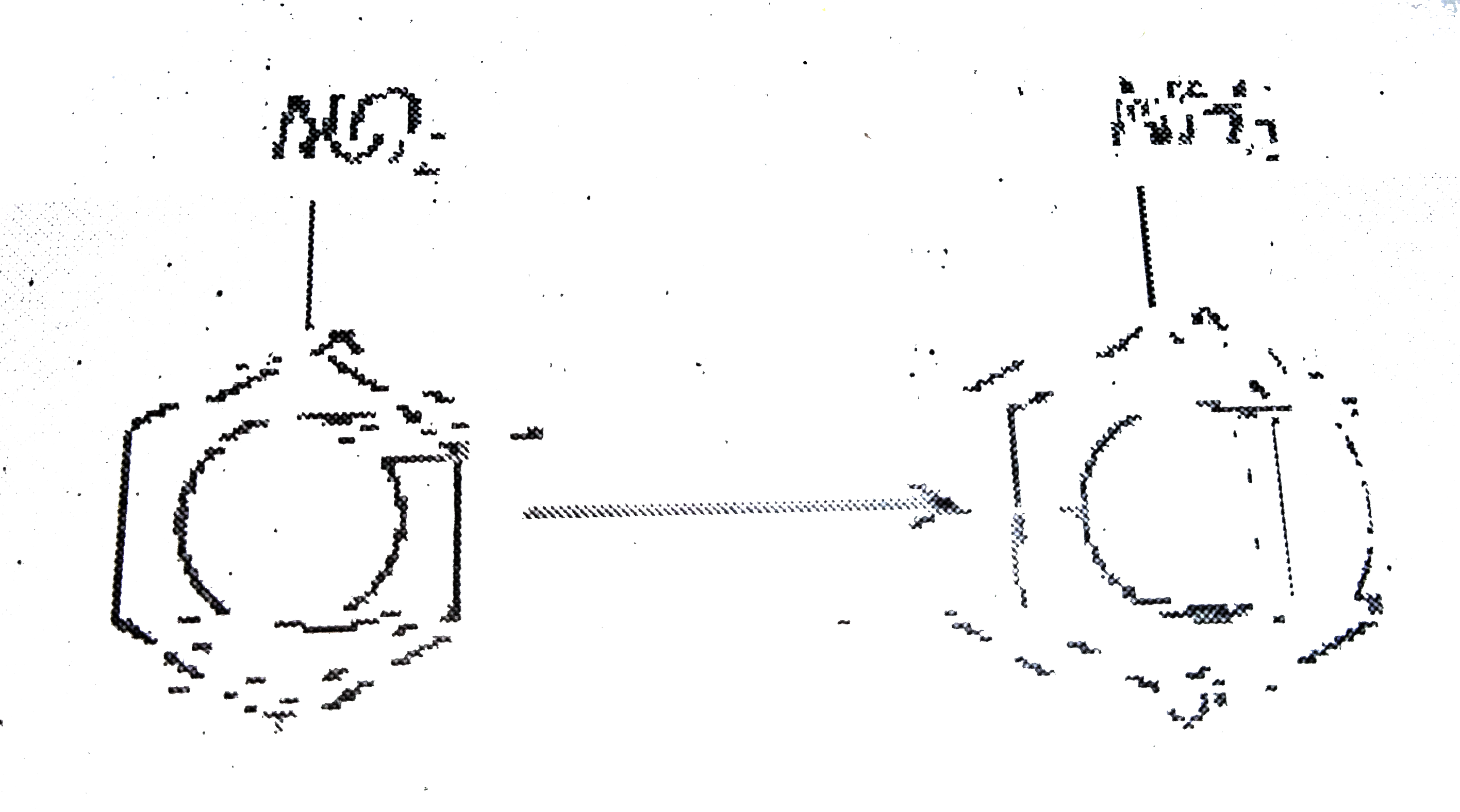Complete Solutions to CHEMISTRY of chapter AIIMS 2016 of Class 12 book with complete answers and questions
| Class 12 | CHEMISTRY |
| Chapter | AIIMS 2016 |
| AIIMS PREVIOUS YEARS | CHEMISTRY |
| Number Of Questions | 60 |
| Academic Year | 2023-24 |
According to Bohr’s theory, which of the following correctly represents the variation of energy and radius of an electron in nth orbit of H-atom?
View SolutionFor which of the following elements it is difficult to disproportionate in +3 oxidation state?
View SolutionBest reagent for the conversion of `AgNO_(3)` to Ag is
View SolutionHow many Faradays of electricity are required for the given reaction to occur?
`MnO_(4)^(-) rarr Mn^(2+)`
View Solution`K_(p)` for the reaction `A hArr B` is 4. If initially only A is present then what will be the partial pressure of B after equilibrium ?
View SolutionPaints and hair creams are respectively
View SolutionChlorine oxidizes sodium thiosulphate to form
View SolutionLarge difference in boiling points is observed in
View SolutionBenzaldehyde can be prepared from
View SolutionThe acidic strength of the given compounds follows the order
I. `CH_(3)-CH=CH-overset(O)overset(||)C-OH`
II. `CH_(3)-overset(..)underset(..)O-CH=CH-overset(O)overset(||)C-OH`
III. `CH_(3)-CH_(2)-overset(O)overset(||)C-OH`
View SolutionEase of nucleophilic addition in the given compounds is

View SolutionWhich of the following reagents cannot be used for the given conversion?

View SolutionArrange the given compounds in decreasing order of boiling points.
`CH_(3)underset(I)(CH_(2))CH_(2)Br" "CH_(3)-overset(CH_(3))underset(II)underset(CH_(3))underset(|)overset(|)C-Br`
`CH_(3)-CH_(2)-underset(III)underset(CH_(3))underset(|)(CH)-Br`
View SolutionWhich of the following molecules has more than one lone pair ?
View SolutionIf an atom crystallizes in bcc lattice with `r=4 Å` then the edge length will be
View SolutionThe reaction,
`C_(6)H_(5)ONa +CO_(2)+H_(2)O rarr C_(6)H_(5)OH+NaHCO_(3)`
suggests that `:`
View SolutionA first-order reaction which is `30%` complete in `30` minutes has a half-life period of
View SolutionWhich of the following is not an aromatic species ?
View Solution10 mL of liquid carbon disulphide (specific gravity 2.63) is burnt is oxygen. Find the volume of the resulting gases measured at STP.
View SolutionSubstances that are oxidized and reduced in the following reaction are respectively.
`N_(2)H_((4)(l))+2H_(2)O_((2)(l))rarrN_(2(g))+4H_(2)O_((l))`
View SolutionThe heat liberated when `1.89 g` of benzoic acid is burnt in a bomb calorimeter at `25^(@)C` increases the temperture of `18.94 kg` of water by `0.632 ^(@)C`. If the specific heat of water at `25^(@)C` is `0.998 cal//g "deg"`, the value of the heat of combustion of benzoic acid is
View SolutionTwo elements `A` and `B` form compounds having molecular formula `AB_(2)` and `AB_(4)`. When dissolved in `20 g` of benzene, `1 g`of `AB_(2)` lowers the freezing point by `2.3 K`, whereas `1.0 g` of `AB_(4)` lowers it by `1.3 K`. The molar depression constant for benzene is `5.1 K kg mol^(-1)`. Calculate the atomic mass of `A` and `B`.
View SolutionWhich of the following reactions does not take place?
`BF_(3)^(-)+F^(-)rarrBF_(4)^(-)" ....(I)"`
`BF_(3)+3F^(-)rarrBF_(6)^(3-)" ...(II)"`
`AlF_(3)+3F^(-)rarrAlF_(6)^(3-)" ....(III)"`
View SolutionThe freezing point of solution containing `0.2 g` of acetic acid in `20.0 g` of benzene is lowered by `0.45^(@)C`. Calculate the degree of association of acetic acid in benzene.
`(K_(f)=5.12 K^(@) mol^(-1) kg^(-1))`
View SolutionWhich of the following alkenes will give same product by any method out of hydration, hydroboration-oxidation and oxymercuration-demercuration?
View SolutionAn element X belongs to fourth period and fifteenth group of the periodic table. Which one of the following is true regarding the outer- electronic configuration of X ? It has
View SolutionWhich is not classified as thermoplastics?
View SolutionSelect the correct statement.
View SolutionFour diatomic species are listed below in different sequences. Which of these represents the correct order of their increasing bond order?
View SolutionThe true statement for the acids of phosphorus, `H_(3)PO_(2), H_(3)PO_(2) and H_(3)PO_(4)` is
View SolutionWhich of the following can be oxidized by `SO_(2)`?
View SolutionWhich one of the following does not give white precipitate with acidified silver nitrate solution?
View SolutionOil used as frothing agent in froth-floatation process is
View SolutionWhich of the following amines gives positively the carbylamine test?
View SolutionDuring the decomposition of `H_(2)O_(2)` to give oxygen, `48 g O_(2)` is formed per minute at a certain point of time. The rate of formation of water at this point is
View SolutionA conductivity cell has a cell constant of `0.5 cm^(-1)`. This cell when filled with 0.01 M NaCl solution has a resistance of 384 ohms at `25^(@)C`. Calculate the equivalent conductance of the given solution.
View SolutionArsenic drugs are mainly used in the treatment of :
View Solution`"Glucose"overset("HCN")rarroverset("Hydrolysis")rarroverset("HI, heat")rarrA, A` is
View SolutionThe major organic product formed in the following reaction is

View SolutionAmong the following the achiral amino acid is:
View SolutionAssertion : `H_(3)BO_(3)` is a weak acid.
Reason : Water extracts the proton of `H_(3)BO_(3)`.
View SolutionAssertion : When acetamide reacts with `NaOH and Br_(2)`, methyl amine is formed.
Reason : The reaction occurs through intermediate formation of isocyanate.
View SolutionAssertion : Chlorobenzene is more reactive than benzene towards the electrophilic substitution reaction.
Reason : Resonance destabilizes the carbocation.
View SolutionAssertion : `Co[Hg(SCN)_(6)] and Hg[Co(SCN)_(6)]` are isomers.
Reason : `SCN^(−)` is a stronger ligand as compared to `NCS^(−)`
View SolutionAssertion : Acetone and aniline shows negative deviations.
Reason : H-bonding between acetone and aniline is stronger than that between acetone-acetone and aniline-aniline.
View SolutionAssertion : Generally alkali and alkaline earth metals form superoxides.
Reason : There is single bond between O and O in superoxides.
View SolutionAssertion : For hydrogen like species, energy of an electron in a particular orbit increases with increase in value of Z.
Reason : Electronegativity decreases across a period.
View SolutionAssertion : Charcoal is used in separation of noble gases.
Reason : Charcoal has porous structure.
View SolutionAssertion : bond angle is less than the normal tetrahedral bond angle.
Reason : Lone pair-lone pair repulsion decreases bond angle.
View SolutionAssertion : Critical temperature of `CO_(2)" is "304 K,` it cannot be liquefied above 304 K.
Reason : At a certain temperature, volume `prop 1//` pressure.
View SolutionAssertion : Phenol is more acidic than ethanol.
Reason : Phenoxide ion is resonance stabilized.
View SolutionAssertion : Diamagnetic substances are not attracted by magnetic field.
Reason : Diamagnetic substances have no unpaired electrons.
View SolutionAssertion : Staggered conformation of ethane is `12.5 kJ mol^(−1)` more stable than the eclipsed conformation.
Reason : The two conformations of ethane cannot be separated at room temperature.
View SolutionAssertion (A): A reaction which is spontaneous and accompained by decreases of randomness must be exothermic.
Reason (R ) : All exothermic reactions are accompained by decrease of randomness.
View SolutionAssertion : `H_(2)S` is stronger acid than `PH_(3)`.
Reason : S is more electronegative than P, conjugate base`HS^(− )`is more stable than `H_(2)P^(−)`.
View SolutionAssertion : 2-Methyl-1, 3-butadiene is the monomer of natural rubber.
Reason : Natural rubber is formed through anionic addition polymerization.
View SolutionAssertion (A) The Duma’s method is of more general application to nitrogen containing organic compounds than the Kjeldahl’s method.
Reason (R ) The Kjeldahl’s method does not give satisfactory results for eompomds in which nitrogen is directly linked to oxygen.
View SolutionAssertion`:` A solution of sucrose in water is dextrorotatory. But on hydrolysis in the presence of a little hydrochloric acid, it becomes laevaorotatory.
Reason `:` Sucrose on hydrolysis gives unequal amounts of glucose and fructose. As a result of this, change in sign of rotation is observed.
View SolutionAssertion : In electrolysis, the quantity of electricity needed for depositing 1 mole silver is different from that required for 1 mole of copper.
Reason : The molecular weights of silver and copper and different.
View SolutionAssertion : Heat of neutralization for both `H_(2)SO_(4) and HCl` with NaOH is `53.7 kJ mol^(−1)`.
Reason : Both `HCl and H_(2)SO_(4)` are strong acids.
View Solution
CHEMISTRY questions and complete solutions for chapter AIIMS 2016 of AIIMS PREVIOUS YEAR PAPERS of Class 12